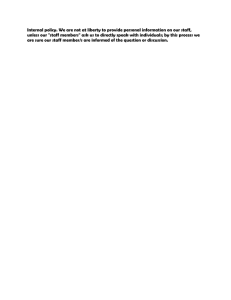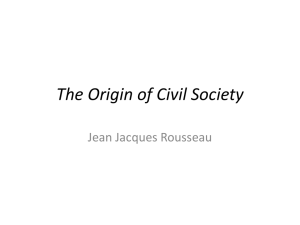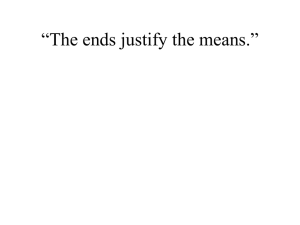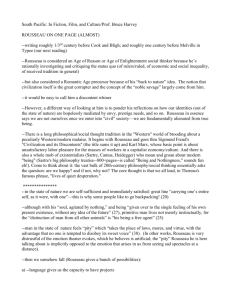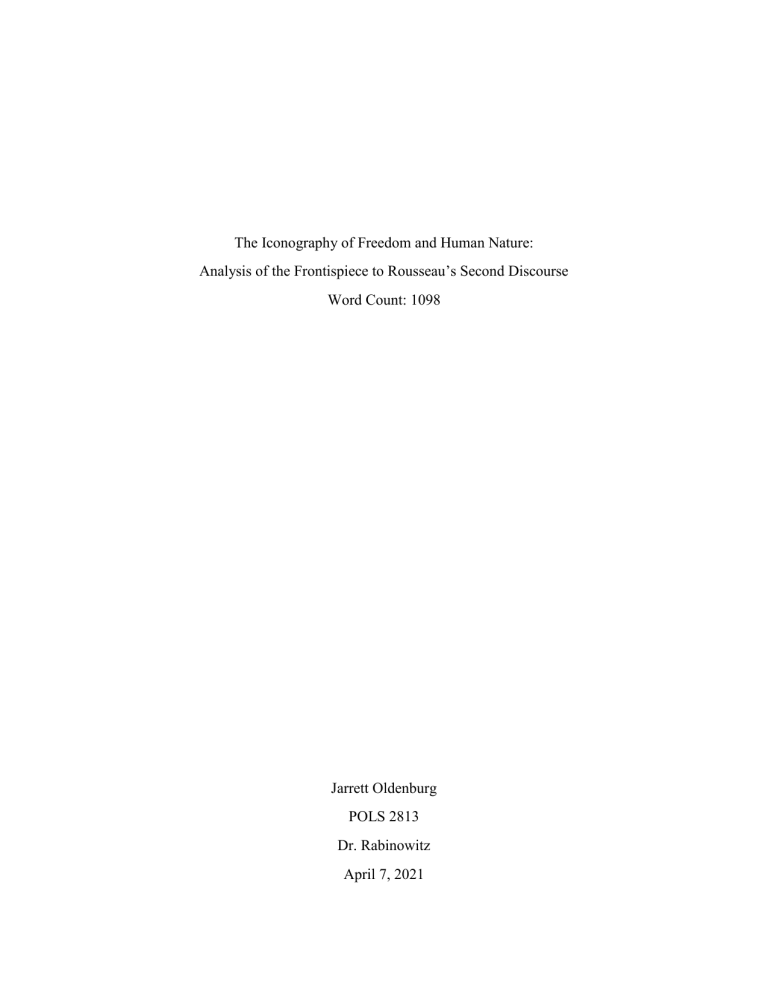
The Iconography of Freedom and Human Nature: Analysis of the Frontispiece to Rousseau’s Second Discourse Word Count: 1098 Jarrett Oldenburg POLS 2813 Dr. Rabinowitz April 7, 2021 The frontispiece of Rousseau’s Discourse appears to me to reflect three central themes, which make up much of the discussion in the volume. These themes are: Firstly, freedom in the state of nature, represented by ‘Lady Liberty’ and the quote taken from Aristotle’s politics. Next, the voluntary association of free actors, represented primarily by the cat seated at the feet of Liberty. Finally, the removal of arbitrary restrictions imposed by man, symbolized by the Phrygian cap, broken shackles, and bird escaping from a cage. Rousseau’s state of nature is fundamentally different from the earlier model proposed by Hobbes. As it stems from a more generous perception of human instincts, it is not nearly the condemnation of ‘uncivilized’ man as can be found in Leviathan. In fact, it is rather more praiseworthy. The key contention of Rousseau is that prior views of the state of nature examined modern man, stripped of the trappings of civilization. Man in this civilization was one that acknowledged inequality and sought to better himself at the expense of others. It is in such a view that a thinker like Hobbes concludes that man prior to civilization would be the same as man stripped of it. Rousseau draws on Aristotle to dispute this, and the quote that appears on the frontispiece: “What is natural has to be considered not in beings that are corrupted, but in those that truly act in accordance with their nature”. Following on from this, ‘beings that are corrupted’ is what Rousseau would contend that civilized man is. A portrayal of man, or rather, a woman is also present on the frontispiece. This specific image is that of Liberty. Portrayed not in the context of an urban environment, or amongst any of the structures of society but in an environment of trees and, put simply, nature. This juxtaposition is intentional, purposefully showing liberty present in nature. The figure lacks any complex dress, or ornamental aspects, none of the ‘corruption’ of society, as Rousseau may frame it. Together, these two elements of Liberty and the quote from Aristotle allude to the idea Rousseau presents of nature, and the natural state of things, not as violent, full of injustice and lacking freedom for those trapped within. Rousseau’s concept of nature is shown to be one of maximized freedom. If it is established that the state of nature is one of freedom, and civilization is a corruption of nature, the inevitable conclusion is that civilization is also a loss of freedom. Civilization being nothing more than a man-made construction, and a falsehood at that as he attributes its origin to one convincing another that some land was ‘his’ without any truth to it (Second Discourse, 113), it imposes a range of artificial constructs. These artificial constructs included some of the earliest relations between men, those in which one relied upon another’s assistance to complete some task, and from that the potential to gain advantage over one another. This is where Rousseau argues inequality begins, and it is compounded by the increasing to degree to which individuals are related in this fashion to others in their society. These relations begin to form a mostly inescapable bond, and in doing so pull man further away from his natural state of freedom. This idea is borne out in multiple elements of the frontispiece, interestingly as escapes from these artificial bonds. We can observe the shackles, most clearly correlated with this sort of imprisonment, and additionally, as an instrument of slavery. Slavery specifically is noted as an outcome following property and labour, stemming from the new inequalities. The next element in this theme is the Phrygian cap being held aloft by liberty, another association with slavery specifically. An indication of the emancipated status of Roman slaves it, it is alongside Liberty in this state of nature, as such slavery could not arise in this context, according to Rousseau. Puzzlingly however, it is a positive sign of freedom, a mark of its presence as opposed to the lack of shackles which would be the indication of freedom. The final depiction of this idea is found in the form of a bird cage. In this case, the cage is not just present as an artifact, but the bird escaping from its confines is portrayed. This demonstrates similarly to the shackles being broken, the actual act of breaking free. Additionally, the now liberated bird is able to spread its wings and fly, reaching its’ natural potential, far above that it was restricted to. This inclusion of the bird is conspicuous, indicating to me that it holds this kind of significance. Looking to the text, as Rousseau provides an unflattering at best view of the condition of civilized man, the clear analogue is indeed the potential to excel at natural proficiencies without societal bounds. We can see a case of this thinking where he claims, “most of our ills are of our own making” (Second Discourse, 93). These elements all allude to the inherent issues that Rousseau finds in society and the degradation of freedom. The final part of the image to take not of is the cat present at the feet of Liberty. The second animal pictured, and one considered domesticated, unlike the bird. This animal is not livestock either, who could be viewed to live in a from of slavery as well. Rather, this animal is one that more commonly serves as a companion. Unlike a dog, commonly considered ‘man’s best friend’, cats are generally regarded as more independent and less admiring of their master, if they can be said to have one at all. In many ways then, the cat is more akin to man, while still being distinct. The cat’s presence, in an apparent state of comfort, is next to the figure of Liberty. This would seem to represent a free choice, a choice to voluntarily associate with another, not stemming from the threat of violence, or the deprivation of any natural freedom. Where the earlier addressed symbols are those of freedom being reclaimed, this is the first step towards its disappearance, the beginning of relations between individuals, and if one comes to rely upon another, then the path Rousseau lays out would follow on. Each of these elements is clearly meaningful, and upon inspection relate clearly to the subject matter of the discourse. They also draw attention to what Rousseau may have considered the most crucial aspects of his work, without stating it outright. Undoubtedly clear is the immense emphasis placed on the idea of freedom, or liberty, in contrast to the work of Hobbes especially with its more authoritarian elements. Reflections: In this paper, I feel that many aspects of what Rousseau wrote about are not able to be covered, as relates to the frontispiece, or my analysis of it was not thorough enough to do so. Nonetheless, I think that the 3 symbols of reclaiming freedom are the source of the strongest points I was able to make, and am happy with that portion of the essay. The voluntary association attributed to the cat seems to be the most tenuous link, especially as the text covers this idea the least. However, it is one I find striking and would like to look further into Rousseau to see if there is more that could support this idea.
